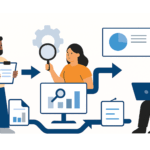Collecting Useable Data: Turning Measurement into Learning
Across the development and humanitarian sector, data often described as “the backbone of accountability” plays a extremely vital role. We use it to measure progress, assess impact and justify funding, But as practitioners, an important question keeps surfacing in MEAL and program management:
- How can we collect meaningful data that truly supports learning, action and decision-making without overwhelming the communities we aim to serve?
The answer lies not in collecting more, but in collecting better. Collecting meaningful, useable data that turns measurement into learning and evidence into action
What Is Meaningful Data?
Meaningful data is information that helps people understand change, not just record it. It connects evidence to experience. It’s the kind of data that answers why change is happening, who it benefits, and what needs to be adapted next.
In a well-designed MEAL system, meaningful data is:
- Purpose-driven: Collected to answer specific learning or accountability questions.
- Relevant: Directly connected to program goals, community priorities and decision-making.
- Timely: Available early enough to inform adjustments during implementation, not just after.
- Contextualized: Interpreted alongside local knowledge, not detached from it.
For instance, a program tracking women’s participation in livelihoods activities may show that attendance is high, but deeper, qualitative data could reveal that few women feel empowered to speak during meetings. That second layer of insight is what makes the data meaningful.
Meaningful data turns numbers into narratives and statistics into understanding
What Is Useable Data?
While meaningful data provides insight, useable data turns that insight into action. It’s data that communities, staff and partners can interpret, discuss, and apply to make decisions. Useable data has three defining qualities:
- Accessibility: Information is shared back in formats that are easy to understand.
- Actionable. It informs concrete steps revising an activity, shifting timelines or addressing emerging needs.
- Collective Ownership. The people who provide the data also participate in interpreting it.
Together, meaningful and useable data ensure that monitoring isn’t just a reporting exercise, it becomes a tool for reflection, learning, and adaptive management.
Best Practices for Collecting Useable and Meaningful Data
Collecting meaningful data begins with purpose. Before launching a survey, developing a logframe or designing indicators, first take a moment to pause and ask these simple yet crucial question:
- What decision will this data help us make?
- Who will use it and how?
- How will we share it back with those who provided it?
Starting with these questions ensures that every data point connects directly to a learning or accountability purpose while helps reducing unnecessary data requests and duplication between partners. Here are practical steps to ensuring data remains both useful and ethical.
- Start with Purpose, Not Templates: Before designing a data collection tool, identify the decisions your data will support by understanding:
- What are the key learning questions for this project?
- Who needs this data and when?
- How will it be used to improve programming?
Designing from questions rather than templates ensures that every data point has a clear purpose and reduces unnecessary data requests or duplication.
Example: Before launching a youth livelihoods survey, a team might clarify whether the data will inform targeting, design or advocacy. This clarity shapes both the tools and the questions.
- Co-Design with Communities:
Involve community members in defining what success looks like. When communities identify the outcomes that matter most data becomes grounded in lived experience, not external assumptions. Through the CoLMEAL Approach, we’ve seen how community-led data collection can generate clear priorities: from deciding what change they most want to track, to identifying and suggesting which outcomes matter most to them. This doesn’t just improve data quality, it turns monitoring into a process of empowerment as it also makes later reflection sessions more meaningful because communities can see progress on what they chose to measure. When communities help define what success looks like, the data collected becomes immediately more relevant.
- Prioritize Quality over Quantity: It is tempting to want gather as much data as possible “just in case.” But large datasets can be difficult to manage and often hide the insights we really need. Instead, identify a small set of indicators or qualitative questions that are truly aligned with your project’s theory of change or learning goals. Fewer questions asked well, usually produce richer, more reliable insights.
- Balance Quantitative and Qualitative Approaches: Numbers tell us what happened. Stories, focus groups and participatory exercises explains why. So combine both! Quantitative data ensures consistency and comparability; qualitative data ensures context, relevance and depth. Together, they create a more complete picture of change, one that captures not just outcomes, but meaning.
- Integrate Reflection Throughout the Project Cycle: Learning shouldn’t wait until the endline. Build short, recurring “pause and reflect” moments into implementation like quarterly reviews, learning workshops or even informal debriefs. Each reflection turns raw data into insight and ensures that communities remain informed and engaged in decision-making. These small steps make data immediately useful as it reduces the need for repetitive surveys, since teams are already learning in real time.
- Share Back and Close the Loop: After collecting data, return the findings to those who shared them. This not only validates community contributions but also strengthens accountability and collaboration. It’s a simple practice that reinforces trust and creates space for local interpretation, turning data collection into dialogue and dialogue into accountability.
Conclusion: Learning with Data
Data will always be vital to our work in the development sector but but collecting more does not always mean knowing more. The future of impact measurement lies in collecting useable data that informs action, strengthens relationships and empowers communities because when every data point serves a purpose and every question builds understanding, data becomes what it was always meant to be — a bridge between knowledge and action.
In the end, meaningful impact isn’t measured by how much data we gather but by how well it is measured by how well we listen, learn, and act on what communities share.



